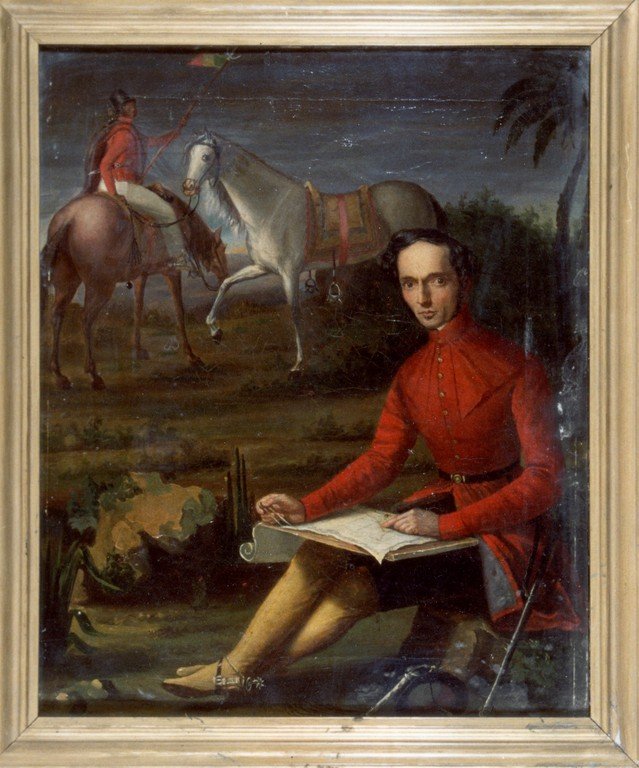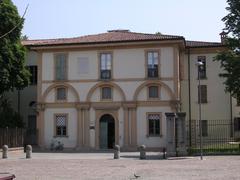
Museum of the Risorgimento Bologna: Visiting Hours, Tickets, and Historical Sites Guide
Date: 14/06/2025
Introduction
The Museo Civico del Risorgimento in Bologna stands as a significant cultural landmark, illuminating Italy’s journey to unification during the 19th century. Set within the historic Casa Carducci, the museum’s meticulously curated collections include artifacts, documents, and personal memorabilia from the Napoleonic era through World War I. Visitors can engage with Bologna’s pivotal role in the Risorgimento, explore the preserved apartment and library of Nobel laureate Giosuè Carducci, and benefit from accessible resources, virtual tours, and practical visitor information. This comprehensive guide details all you need to plan an enriching visit, including insights into the museum’s history, collections, visiting hours, ticketing, and nearby attractions (napoleon.org; bolognawelcome.com; museibologna.it).
Table of Contents
- Introduction
- Museum Origins and Historical Background
- Thematic Organization and Highlights
- Notable Collections and Artifacts
- Casa Carducci: Literary Legacy
- Visiting Hours and Tickets
- Accessibility and Visitor Services
- Getting There and Nearby Attractions
- Visuals, Virtual Tours, and Media
- Frequently Asked Questions (FAQ)
- Conclusion
- References
Museum Origins and Historical Background
The Museo Civico del Risorgimento was established in 1893 amid a surge of national consciousness following Italy’s unification. Its creation was inspired by the success of the “temple to the Risorgimento” exhibit at the 1888 Esposizione Emiliana. Initially located within the Municipal Museum, it was intended to foster patriotic values, particularly among youth, and support historical research through its library and archives (napoleon.org).
In 1990, the museum relocated to Casa Carducci, a 16th-century building reconstructed in the 18th century and later home to the celebrated poet Giosuè Carducci from 1890 to 1907. This move deepened the museum’s cultural and historical significance, blending literary heritage with the narrative of national unification (bolognawelcome.com).
Thematic Organization and Highlights
The museum’s exhibitions chronologically trace Italy’s transformation from the Napoleonic era through the aftermath of World War I, organized into five principal sections:
1. The Napoleonic Period (1796–1815)
This gallery explores the impact of French occupation, introducing radical reforms, the Cisalpine Republic, and republican ideals. Displays include contemporary pamphlets, prints depicting Liberty trees, and proclamations reflecting sweeping social change (napoleon.org).
2. The Restoration (1815–1848)
Following Napoleon’s defeat, Bologna experienced conservative restoration and suppression of revolutionary movements. The museum exhibits allegorical engravings and documents illustrating both resistance and the endurance of revolutionary ideals.
3. The Risorgimento (1848–1861)
This pivotal section recounts the struggle for Italian unity, including Bologna’s central role in the 1848 uprisings. Notable artifacts include battle uniforms, weapons, and memorabilia from the Battle of Montagnola—when citizens expelled Austrian troops (travelemiliaromagna.it).
4. Italian Unity (1861–1914)
The galleries examine the consolidation of the Italian state, the integration of Bologna, and the development of national identity through civic institutions and social reforms.
5. Bologna at War (1914–1918)
This section highlights local experiences during World War I, focusing on the city’s contributions and the war’s societal impact.
Notable Collections and Artifacts
The museum’s collections provide a comprehensive view of the Risorgimento and its legacy:
- Military Memorabilia: Features arms belonging to Joachim Murat, including double-action hunting rifles and a flintlock pistol by Boutet (1804), donated by Letizia Murat (napoleon.org).
- Flags and Regalia: Includes the green, white, and red flag of the National Guard—a symbol of Italian identity—and a standard presented to Napoleon in 1805.
- Documents and Prints: Revolutionary pamphlets, political proclamations, and rare newspapers illustrate the era’s social upheavals.
- Personal Effects: Letters, diaries, and artifacts from Bologna’s patriots and national leaders.
- Art and Sculpture: Statuettes and paintings depicting key figures and historical moments.
- Philatelic Collection: Donated by Giorgio Tabarroni, this collection comprises stamps and documents on Mediterranean postal systems during unification (museibologna.it).
- War Memorial Archive: Online documentation of Italian monuments and memorials related to World War I.
Casa Carducci: Literary Legacy
On the museum’s first floor, visitors can explore the preserved apartment and library of Giosuè Carducci, Nobel laureate and university professor. The library houses rare editions from the 16th to 19th centuries and Carducci’s manuscripts, providing insight into the intellectual life of post-unification Italy (bolognawelcome.com).
Visiting Hours and Tickets
-
Regular Hours:
- Tuesday: 9:00 am – 1:00 pm
- Thursday: 9:00 am – 1:00 pm, 3:00 pm – 7:00 pm
- Friday to Sunday: 10:00 am – 6:00 pm
-
Closed: Mondays, Wednesdays, May 1st, December 25th, and for summer maintenance (typically late July to mid-September; check ahead)
(museibologna.it; bolognawelcome.com) -
Tickets:
- Standard admission: €5 (subject to change)
- Discounts for students, seniors, and groups
- Free entry for children under 18 and Bologna Welcome Card holders
- Tickets available online and onsite
- Group tours and educational workshops available by reservation
Accessibility and Visitor Services
- Wheelchair Accessible: Ramps and elevators ensure access throughout the museum.
- Audio-Tactile Routes: Tactile maps, audio guides, and Braille texts for visually impaired visitors (bolognawelcome.com).
- Guided Tours: Offered in Italian and English (advance booking recommended).
- Visitor Amenities: Bookshop, educational materials, free Wi-Fi in library, photo archive access.
Getting There and Nearby Attractions
Location: Piazza Carducci 5, 40125 Bologna, Italy, in the Santo Stefano (Galvani) district (Bologna Welcome; Trek Zone).
- By Bus: Several city lines stop near Piazza Carducci.
- On Foot: Approx. 15-minute walk from Piazza Maggiore.
- By Car: Limited parking due to Bologna’s ZTL; public transport advised.
Nearby Attractions:
- Casa Carducci (upstairs from the museum)
- Certosa di Bologna (monumental cemetery)
- Archiginnasio, Basilica di Santo Stefano, Asinelli Tower, and additional museums such as Palazzo Pepoli (museibologna.it; trek.zone)
Visuals, Virtual Tours, and Media
- High-quality artifact images and virtual tours are available via the museum’s website.
- Interactive maps and digital archives enhance both in-person and remote engagement (museibologna.it).
- Alt text descriptions support accessibility for all visitors.
Frequently Asked Questions (FAQ)
Q: What are the museum’s opening hours?
A: Tuesday 9:00 am–1:00 pm, Thursday 9:00 am–1:00 pm and 3:00 pm–7:00 pm, Friday–Sunday 10:00 am–6:00 pm. Closed Mondays, Wednesdays, major holidays, and during summer maintenance.
Q: How much do tickets cost?
A: Standard admission is €5, with discounts for students/seniors/groups. Free for children under 18 and Bologna Welcome Card holders.
Q: Is the museum accessible for people with disabilities?
A: Yes, the museum offers full wheelchair access and an audio-tactile route for visually impaired guests.
Q: Are guided tours available in English?
A: Yes, upon request; please book in advance.
Q: Is photography allowed?
A: Non-flash photography is generally permitted for personal use; restrictions may apply during special exhibitions.
Q: How do I reach the museum?
A: Located at Piazza Carducci 5, accessible by bus or on foot from the city center.
Conclusion
The Museo Civico del Risorgimento is an essential destination for anyone interested in Italy’s unification and Bologna’s cultural legacy. With thoughtfully curated collections, accessible facilities, and engaging educational programs, the museum bridges the past and present—fostering historical knowledge and civic pride. Before planning your visit, always check the latest updates on opening hours, ticketing, and exhibitions via the museum’s official channels. To further enrich your experience, consider exploring related Bologna historical sites and utilizing digital resources for virtual engagement. Download the Audiala app for audio guides and event updates, and subscribe to newsletters for the latest cultural offerings.
References and Further Reading
- Museo Civico del Risorgimento Bologna: Visiting Hours, Tickets & Historical Insights, 2024, napoleon.org
- Museo Civico del Risorgimento e Museo di Casa Carducci, bolognawelcome.com
- Visiting Museo Civico del Risorgimento in Bologna: Hours, Tickets, and Historical Insights, 2024, travelemiliaromagna.it
- Museo Civico del Risorgimento in Bologna: Visiting Hours, Tickets, and Highlights, 2024, informa.comune.bologna.it
- Museum of the Risorgimento Visiting Hours, Tickets & Insider Guide to Bologna Historical Sites, museibologna.it, trek.zone
































